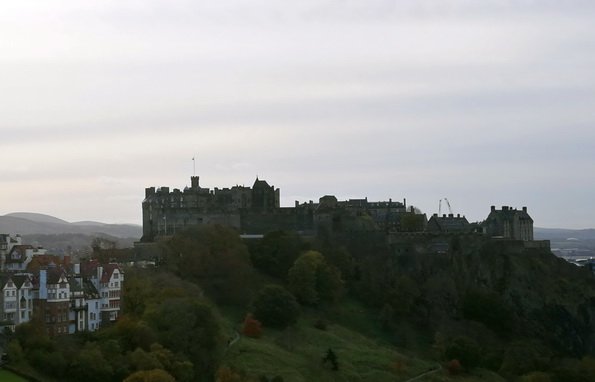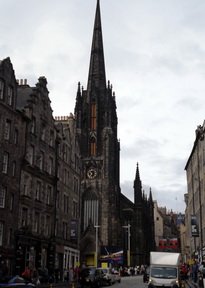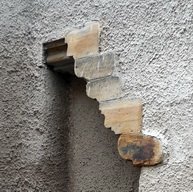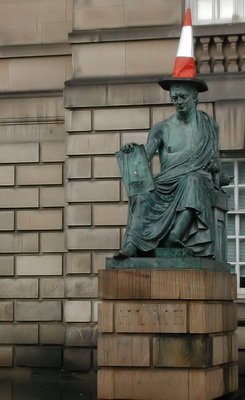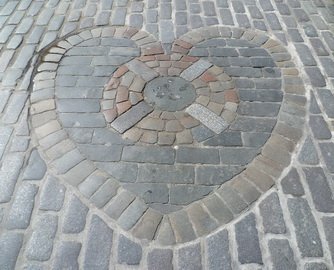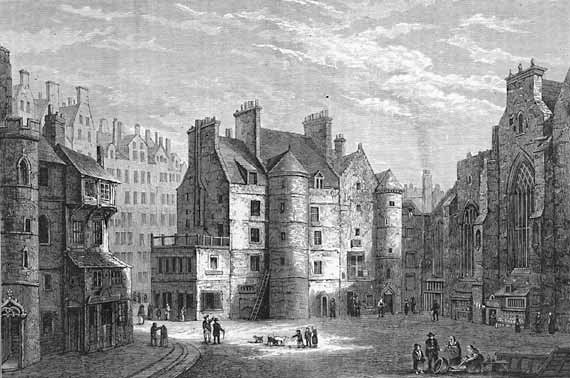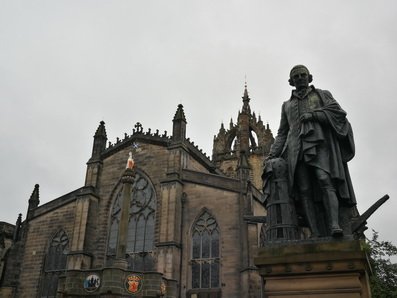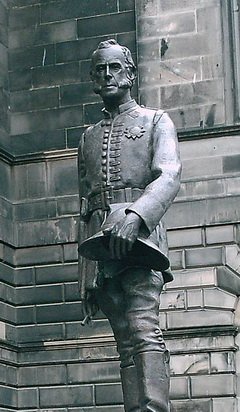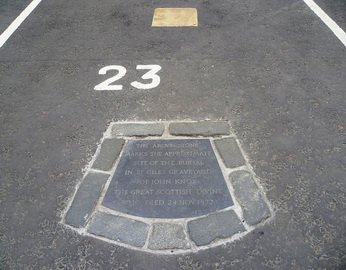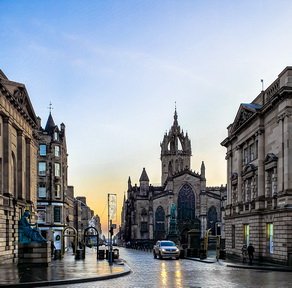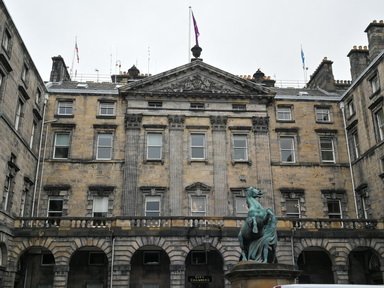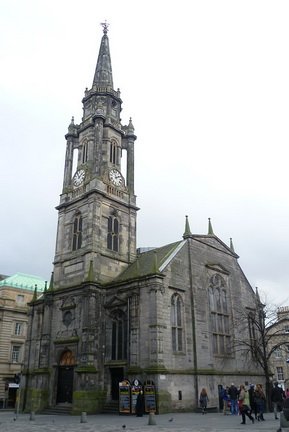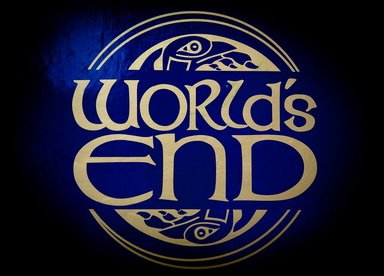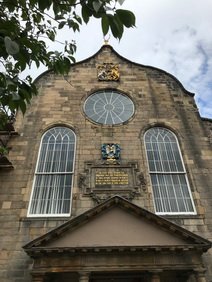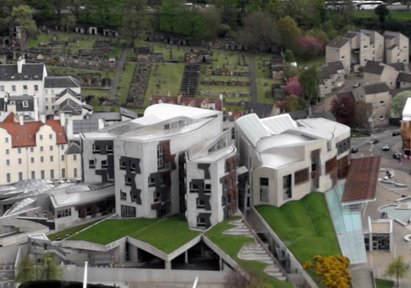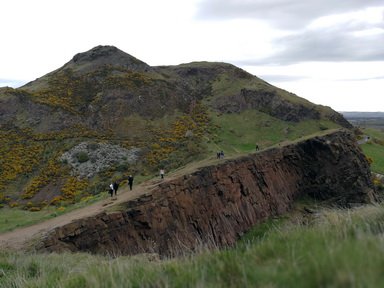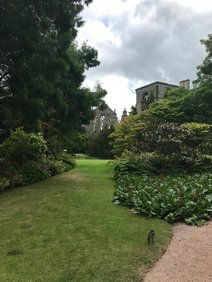Royal Mile Walk
Castle of Edinburgh – Holyrood Palace
1 Castle Esplanade – 2 Edinburgh Castle – 3 Witches’ Well – 4 The Hub – 5 Gladstone Land – 6 Deacon Brodie Story – 6.5 Writer’s Museum – 7 Highstreet beginnings & David Hume – 8 Luckenbooths and Heart of Midlothian – 9 Mercat Cross – 10 Adam Smith & James Braidwood – 11 Parliament Square – 12 John Knox’s Grave – 13 St Giles Cathedral – 14 City Chambers – 15 Tron Kirk & South Bridge – 16 John Knox House Corner – 17 Netherbow Port & World’s End – 18 Canongate – 19 Canongate Tolbooth & Kirkyard – 20 THe New Scottish Parliament – 21 Holyrood Hills – 22 Holyrood Palace & Abbey
W
here to start?
The Royal Mile is the best answer because all the main points are situated there. Or as people call it – the Old Town. Meaning that the New Town will be your second walk.
Royal Mile connects the Castle with the Holyrood Palace. It is 1/8 normal mile long and today is divided into segments called: Lawnmarket, Highstreet and Canongate.
The natural geography of the place makes the Royal Mile go down from the Castle Hill, which was a volcano once. During Ice Age the glacier shaped a natural ramp, making this road the only easy access to the top of the hill. Everywhere else were the steep slopes. Not so much of them now, but once it shaped all the town. Making the Royal Mile the central axis, as in the skeleton of the fish – with the bones going left and right to the, still visible, valleys. They were and are called now Wynds and Closes – and they are what you definitely need to explore.
This specific walk will take you from the Castle to the Highstreet. There you will find St. Giles Cathedral, Mercat Cross and others. Going down you will arrive at the World’s End Pub where Canongate street starts. It will lead you to the Palace, where the walk ends. It will give you the highlights and directions. You can also download the print version (text and map) and use it in the city.
The walk takes about 90 minutes although it mostly depends on your imagination. If you find something interesting to explore – go for it. Have fun and enjoy the place.
1 Castle Esplanade
Looking at the Castle you have North on the right and South on the left. Try walking to the edges of the Esplanade to take in the views.
You managed to reach the top and the Castle esplanade. Reward? A wonderful view of the surroundings if you are lucky enough and there is no festival scaffolding around you (it is there from the beginning of July through to September).
The view to the North shows you the New Town – the invention of James Craig and the provost George Drummond – the XVIII’s century dream to make the city bigger and more beautiful. On your feet – the Princes Street Gardens, full of statues, flowers, squirrels and bones. The first road you see is maybe the road that you came to Edinburgh with – the Princes Street. This is where the shops are…. And beyond – Leith, the Firth of Forth and the land on the other side – Kingdom of Fife.
In the gardens you can see two distinct constructions. The Greek columns are not the temples – these are the Art Galleries. The black rocket is the Scott’s Monument. And the bridge is… no it is a bridge, North Bridge to be exact. And right underneath there is the train station called Waverley Station. (more in the New Town walk)
The South view gives you the majestic Pentland Hills – the closest place to a ski slope that Edinburgh has. To the left from them – the inner mountain – the Hollyrood Park with its top called the Arthur’s Seat. You should see the stretch of bare rock there – that’s Salisbury’s Crags. Right underneath your feet there is a place called Grassmarket. What catches your eye is a palace like structure with the towers and a clock. That is the George Heriott School, created by George himself. He was the treasurer to the King James VI/I. He gave money to build a school for orphaned boys where they could learn for free. That is the very school that became an inspiration for J.K. Rowling and combined with the Edinburg Castle created… Hogwarts.
The Esplanade itself is a modern creation from 1753. It was a place for the troops to parade then… and now it is the same, only for both the troops in August and the tourists throughout the year.In August there is a Military Tattoo, and it is one of the most fascinating parts of the Fringe Festival – with Scottish military, bagpipers and fireworks. A month before and after – this place is covered with stadium seats completely destroying the view.
In the North part of the Esplanade you can also find a tomb of Ensign Ewart who captured the Napoleonian eagle at the battle of Waterloo. The metal fence that you see has a gate. If you find it you may decide to walk down the path that will take you to Princes Street Gardens. It offers a shortcut and splendid views as well.
2 Castle of Edinburgh
Approach the castle. It is best to stay in the distance but close enough to see the statues guarding the draw bridge. After the entrance there is a ticket office and another entrance. You can reach the insides of this giant only with a ticket.
Believe it or not but you are almost at the top of a long extinct volcano! The tough lava plug that hardened after millions of years is now called Castle Rock. The glaciers created this characteristic landscape – almost straight walls from three sides, and one way entrance-ramp leading to the castle (called crag and tail formation). It was a safe place with a good view in every direction.
Archaeologists found evidence leading to year 3000 BC, but it could be earlier. The first settlement of Goddodin tribe was created on the spot of today’s castle. Few huts, changed to a fort, a church… a stronghold, a city… a capital of Alba. There inside you have the oldest building in town called Magdalen’s Chapel. It leads back to the times when the descendants of the great Kenneth MacAlpin decided that Edinburgh will be a capital (around XI century).
What you can see now is an effect of at least 26 sieges. This castle is one of the most besieged in Scotland. It suffered greatly during the Wars of Independence – you have two figures welcoming you to the castle to be a proof of that – William Wallace aka Braveheart, and Robert the Bruce with the crown on his head. That is also the time of a film-like-stories about gaining access to the castle, climbing the walls in the night, disguises and many others. Later times brought the inspiration for the Red Wedding from Game of Thrones, the birth of the future king of England – James VI, and a pet semetarrry…. There is plenty of fascinating military museums inside, you can search for signs of French pirates in the dungeons, the views are magnificent, and at 1 o’clock you can see something spectacular.
Ticket costs 19,50/adult. There is a free guided tour inside. A guide book and audio-guide are accessible with additional payment. I can advise you that book is for everyone. Audiobook lasts few hours and is fascinating – but I am a history geek so do not shoot. The minimum time for the castle is 1,5 hour but it can be much more. I recommend it in the morning or after 3 PM when there is less people and queues.
Having seen the castle turn around and start walking “down the Royal Mile”. Go straight without turns – the first road is the Castle Road. Before you enter it – approach the first building on your left – the Tartan Mill souvenir shop.
3 Witches’ Well
At the end of the Esplanade, on the wall of the first building on the left-hand side, there is some ornamentation. When you approach it you should be able to see a panel with a face and a flower pot (in my time).
That is a small reminder of the history of this place. The Esplanade was not always a parade ground. There was a time when witches were burned alive here, especially between XVth – XVIIth centuries. About 4000 people were killed in Scotland. Just in here – on this Esplanade, it was 300 souls!
Scotland may even be the mother of Salem’s persecutions. The worst was in the times of King James VI/I. He wrote Demonologiae – a book telling how to spot witches. When he was about to marry Anne of Denmark, something strange happened… His bride couldn’t come because of the storm. He went for her himself and on their way back another storm threatened the royals’ lives. It was believed that the witches called upon the forces of nature in a satanic ritual in North Berwick. What happened next was worse than Salem.
The relief you see represents the duality of magic. A person wielding it can be both good and evil. A herb in the right quantity can heal, not all snakes are poisonous… Today Edinburgh welcomes magic. Try to come for Beltane Festival – a feast of the witches and magic in April. Let’s not forget about Harry Potter’s inspirations.
Start walking down the Royal Mile. First, pass the Tartan Mill – a mall going 5 stories down, full of souvenirs (also a former water reservoir). Further down there is the Whisky Experience on the right and Camera obscura on the left. The first gives you a story of the most famous spirit (about 1-hour tour) and the second makes you experience the world of illusion (at least 90 minutes).
You should arrive at a huge crossroads. Be careful because it is a roundabout and there is some traffic here. Go to the other side of it, find a spot on the pavement, turn around.
4 The Hub
You should notice a church-like building of black color. It has a tall spire with a clock. Looking at it there is a short street going down to your left. It ends with stairs leading down to Grassmarket. You can check it later – the terrace at its end is called Victoria Terrace. It gives a great view to Victoria Street. Behind you there is the Royal Mile.
The black church in front of you is called the Hub, although its original name is Highland Tolbooth St John’s Church. Its 74 meters high tower is the highest point of Edinburgh and can be seen from various places all over the town.
It is not that old as you think, it comes from XIX c., but gives you impression to be from some dark gothic times. Black color is the effect of smoke clinging to the limestone and staining it overtime. Back in the day, as you know, there was no electricity. Population in Edinburgh was very dense and all those people and places used coal, wood and animal fat to brighten their lives and keep themselves warm. Plus – the railway line is not too far away. Because of the smell and the everlasting smoke surrounding the city, it was even given a nickname – Old Smokey, and it was said that you could smell Edinburgh a few miles ahead.
The church was supposed to be the place for the Assembly of the Church of Scotland but it never happened. Instead it was turned into the headquarter of the Fringe Festival of Arts. Feel free to enter to buy tickets for the shows or drink coffee in a restaurant in there.
Proceed down the Royal Mile. You are at the Lawnmarket section now. It goes to the first set of lights. It is best to go on the right-hand side. The building you are looking for is on the other side of the street. Look for the tenement with exterior stairs, arcades and a distinct gold bird hanging above the heads of pedestrians.
5 Gladstone’s Land and “Gardez-loo story”
The tenement is named after its owner and is a great example of a building from old Edinburgh. Now it holds a fascinating museum telling you the story of how Gladstone family lived in Edinburgh in XVII c, how the kitchen looked, the rooms, how they struggled with witchcraft. The entrance to the souvenir shop is through the arcades. You can also buy your tickets for a guided tour there (careful – there are only timed tours. Check when first).
Looking at it just imagine people then, living in Edinburgh. A row of tenements like that along the Mile, and down the slopes. Not a wide Lawnmarket street of now, but rather narrow passages, narrower because of the stalls of the merchants. No bricks under your feet, but mud back then. Thousands of people cramped in Edinburgh which then had around a square mile. They lived with their livestock or close to the barn. Pigs were roaming the streets. It was dreadful.
Tenements were made of stone and wood. More wood with every floor up. And there were many – up to 14 stories high – a Manhattan of then. In those horrific condition with no running water a Nastiness Act was signed. It regulated when people can empty their urinary pots or buckets. And they were not running up and down the wooden, unstable stairs with it – they just opened the window.
So, the people shouted “Gardez looo!”, and if you were lucky enough, you shouted back “Hold your hand”, and you got about 5 seconds to get out of the street. But just imagine… you were at the bar with friends… and had one dram too many… and your reflex was not too good, that meaning when you heard something you just directed your head/face to the voice….
Edinburgh flowerpots they are called. And an English expression saying you got heavily drunk comes from here, apparently having something to do with the insides of a bucket and a face…
After this gruesome story continue down on the right side of the road. Few meters further there is a statue of a gentleman dressed in red and blue clothes. He is the next story.
6 Deacon William Brodie
The entrance to the Brodie Close gives you another example of old Edinburgh. This is how closes looked like – a street between the tenements closed by a gate. They often led to a court, but here you will find only Brodie’s Café.
This close was a wynd once – that is, it led straight down the hill (there were no gates). Somewhere there lived a family with the name Brodie. Senior Brodie was a carpenter, leader of a Guild, and Deacon in the City Council. His son inherited both positions. His name was William.
He had a great life, a wife and two children. He also had a secret. In the night he was gambling on coque fights. He also had 2 mistresses and 5 illegitimate children!
All those activities drained his pockets. His salary was not enough, but then he had an idea. As a carpenter, he made cabinets, where people stored their valuables. He had access to people’s homes, could easily make a wax print of a key. He knew houses hidden traps. It was a perfect gambit. And his first theft brought him money for a few years.
But addiction is difficult to master. He was in need again, he found friends, and started a gang. The city had to do something! And yes, they did do something – they asked the best of them to organize a search party and finally catch the troublesome thief. Guessed already whom they picked?
We almost got him…
Next time…
Eventually, he made a mistake. He tried to rob a tax office in Canongate. They were spotted, one of them was captured. The prisoner wanted to turn king’s evidence (confess for forgiveness). But Brodie felt that, and by the time police came for him, he was on his way to Amsterdam. There he was caught. In 1788 he was hanged in front of St Giles Cathedral, few steps further down, on the very gallows that he, as the deacon of the carpenters guild, introduced to the city.
His double life gave inspiration to a story written by another famous Edinburgh bred and born… It was Robert Louis Stevenson who took it and turned into Dr. Jekyll and Mr. Hyde’s novel. A few words about him can be seen in the Writer’s Museum (point 6.5).
If you want to go to the Writer’s Museum – cross the street here. Next to the souvenir shop, you will find the entrance to Wardrop’s Court. It is guarded by two blue dragons above your head. When you go inside, you will find yourself in a courtyard. Building on the left, looking like a small castle is the Writer’s Museum.
If not continue to the traffic lights and cross the street.
6.5 Writer’s Museum
The building itself is worth visiting. It is a true town villa from the XVII century with lovely spires, many windows, and ornaments. That one belonged to Lady Stair as we can read on a plaque on the building. Look how scarce is space inside, all those passages from one room to another make a labyrinth, check the staircase.
Watch out there – because there you have an occasion to see an old thief-alarm-system – the false step (height is different). A surprise like that was nothing for people who lived there, who were used to it. But if somebody didn’t know… and tripped and went down making noise or cursed feeling pain. He woke everyone – and that was the point!
The last thing is outside. Under your feet on the courtyard, you can see the quotes in Edinburgh’s name. There is even the Auld Reekie of Robert Fergusson. Can you find it? You can also try to find the sign of the fire insurance – a special mark on the wall, left from the entrance – joined hands that were telling firefighters that this was the first house to take care of.
The museum is free to visit and what you will find inside is a shrine to three most notable writers in Edinburgh. The museum contains souvenirs from their lives and a few words to present them. Sir Walter Scott wrote Waverley Novels. Robert Burns is also known as the national bard of Scotland. Robert Louis Stevenson is the father of Treasure Island.
More about them you will find in a separate article.
From here you need to exit back to the Royal Mile. Direct yourself to the traffic lights. Standing with your back to the Castle you have The Mound Street on your left. Straight – there is the High Street section of the Royal Mile – where this walk continues.
On your right is George IV Bridge and the Grassmarket Walk if you wish. It will add about 70 minutes to the Royal Mile Walk. The decision is yours.
7 High Street beginnings and David Hume
Cross the street going straight, still down the Royal Mile. Try to notice 3 cobbles in H shape on the other side of the pedestrian crossing. You should also see a sitting figure of a man.
Noticed the brass bricks, shaped like an H on the pavement? That is the place marking the last public execution that happened in Edinburgh, in the dark, medieval times of people who didn’t know any better – and that was in 1864. It should be added here – the middle of the Scottish Enlightenment and Industrial Revolution era.
On the opposite side of the road, looking at this reminder of inhuman behavior in the modern world sits David Hume. He may be looking at the “bible” he created, and which made him the father of Philosophy. Or maybe he looks at his favorite place in Edinburgh – Dowie’s Tavern, which stood right where the George IV Bridge is now. In XVII to XIX centuries, it was customary to do business or meet for some serious and bright talks in the pubs. David Hume created his Treaty of Human Nature among the very people giving him the best picture of morality and behavior.
Wondering what the gold toe is all about? Or were you lucky enough to spot some tourists rubbing it? The story is that philosophy students started to rub it for good luck before exams. Everything else was invented.
Follow the Royal Mile, the High Street section, and approach the church of St. Giles. Try to spot cobbles shaped into a heart. They should be close to the left corner of the Cathedral.
8 Luckenbooths and Heart of Midlothian
You are looking at Heart of Midlothian – the heart of the city, people and the region of Scotland that you are now in.
The heart of the poet, who wrote a book called like that (one by Sir Walter Scott).
The name of a local football team.
And a symbol of oppression that you need to spit on (was it an ancient custom?)… Why?
This spot marks the Old Tolbooth which once stood here. It was the house of the city council, local police force, a prison, and an execution point. It was demolished in 1817 and only cobbles mark its shape now. If you forget about the church and follow those cobbles further down, you will see a lot of them. Old Tolbooth was only a part of a big piece standing here, and blocking the way of the carriages. This structure was called Luckenbooth because it had “locked booths” for the merchants here. Mostly jewelers were rich enough to be housed here. Other traders had to take their stall for the night with them and rebuild it the next day.
They weren’t happy when they were kicked out, but they found a worthy place at the South Bridge further down. To express their loss, they created their own Luckenbooth or rather Lucken-brooch – a heart pendant.
If you continue along the cobbles, you should be almost at the end of the church now. There will be a tree and a structure with a column. Approach it.
9 Mercat Cross
Let’s start by saying that this place here, with the church and its surroundings… it is as old as the castle. They both were created in the old days. One was a seat of military power and the other – of the religion.
The building you are looking at was the third part of this medieval trinity – the merchants’ power. Traders met here every day, put their stalls up and sold things. It was not imposing as the beginning. Just a cross on a column. The merchants were enough to show you where the market was. But the capital was unique, and the Mercat Cross had to be special.
It was also a social center. Not only traders, people, and gossip coexisted in this place. The proclamations and executions were held here.
The wonderful building is a reconstruction, built as close to the original as possible. The 8 emblems around it show the symbols of various important places in Edinburgh: like the city itself, the port of Leith, the University. The top is decorated by the symbol of Scotland – the Unicorn. A creature impossible to catch and enslave – as the Scottish nation it represents.
Close to the structure you have two statues. The first is right next to it. The second one is more to the right than the first, in a corner of a building.
10 Adam Smith and James Braidwood
The statue of Adam Smith is the most likely to have a photo taken with. Smith wasn’t born in this city but was both a professor of Glasgow and Edinburgh Universities. One was the city of commerce and shipyards. Second – the city of knowledge, commerce, the capital. In between – he, a student of life and people, fascinated by the economy. While Hume was giving lectures about morality sipping a beer in their favorite pub, Smith was reciprocating with the theories of commerce. The one, which is known the most is called capitalism now and was described by Smith in The Wealth of Nations in XVIII c.
The second statue more to the right is of a man in the uniform. If you look close enough, you will notice that the helmet is the one that the firemen use. As Smith is the father of the economy, so James Braidwood is the father of firefighters. At the beginning of XIX c. the fire was still the most lethal element, feared by everyone. The only ways to fight it were the buckets of water and your feet taking you as far as possible from a burning building. And Edinburgh had a lot of wooden buildings. James knew that. His father was a local architect, and he visited a lot of homes with him. It gave him the possibility to see their inner construction, so fragile and deadly when the fire came. Fascination became an idea. And the idea turned out to become reality in the form of a fire brigade and a fire-engine. He gathered a group of professionals: architects, woodworkers, engineers, sailors. People that could carry their mind or muscle to the fight. And he invented the first red car carrying water. Well – back then there were people, then horses pulling it, but you get the idea. This earned him a place on this pedestal. Maybe he worked mainly in Edinburgh and London, but everyone should be grateful for his brilliant ideas.
After getting to know James Braidwood, you should be able to see a guard post and an entrance to an inner courtyard. It is a parking lot situated behind the Cathedral and the next stop on our way.
11 Parliament Square and the Old Parliament building
Look around you.
Look at the majesty of the buildings surrounding you. The perfect Greek columns, the blocks of stone imitating grandeur, the statues, the tympanums, the sphinxes. Great, ancient nations in one place. All of it together is what made Edinburgh the Athens of the North. Different parts of the city are still built in the neoclassical style from the XVIII-XIX century. This courtyard is one of the best examples of it (also the New Town and monuments on Calton Hill).
The statue on a horse mimics a roman one and represents king Charles II (the grandson of James VI/I). He is looking at a facade of a building. These are the two oldest parts of Parliament Square. If you get close enough to the arcades, you will be able to see a plate with the date 1639.
Left of it, at the corner – there is an entrance. You can go inside if you want to. It is free, just pass the “airport control”. You will find a wonderful hall – a reminder of the first Parliament building in Edinburgh. Now decorated with statues, paintings, stained glass, and the original hammer-beam oak roof.
James Murray was the designer of Parliament Square. The exterior of the buildings was later remodeled by Robert Reid and Robert Adam – followers of the neoclassical movement. Today, these walls house the Court House, Advocates rooms, Library – shortly, everything connected to law.
Try to spot parking lot number 23. It is normally empty and there should be something on the ground there.
12 John’s Knox grave
Parliament Square was a cemetery before. It was moved to Greyfriars, but the memory of its most famous inhabitant remains. John Knox was buried in an unmarked grave, according to his wishes, as you can see. He was a minister of St Giles Church. In XVI c. he brought the fires of Reformation to Scotland.
He also battled, with words, with Mary Queen of Scots. This tragic Scottish heroine came to Edinburgh in a bad time. She was Catholic and post-French in the newly protestant country that feared the French invasion. She was the daughter of King James V. As a child she had to flee to France, where she grew up. Eventually, she returned home to take the throne back. Her time is marked by war for power with John Knox and with the nobles, 2 terrible marriages and a series of mistakes.
Fortunately, the times of her son were much calmer. Protestant King James VI managed to acquire the English crown! He, a Scot, was the heir to the late Queen Elisabeth the Great.
Exit the Parliament Square through a small passage to the left. If you are not sure, just continue to circle the Cathedral. You will find yourself in front of it. If you wish, you may enter – it is free to visit. A detailed walk is accessible here.
13 St Giles Kirk/Cathedral
The first church in Edinburgh was situated in the Castle area. With the creation of the royal burgh a suitable place of worship needed to be created. A small shrine to St Giles is supposed to be here at the beginning – it grew to become a church in the XII century. It grew more gothic in time with its spires and decoration.
Reformation of the XVI century robbed it of its riches and turned it into a protestant place of worship. The interior design changed to fit the new religion. There was no more of the eastern altar. The minister now sermoned from the middle of the temple, with everyone gathered around to hear him correctly. You will see inside this characteristic design.
The church was turned into a seat of a bishop in the XVII and XVIII centuries. These were two brief periods in times of King Charles I and later – by king Charles II. The change was met with a protest from the locals. The most famous one was let by one Jenny Geddes who was so frustrated that she threw a stool at a bishop (you can see a statue inside). Later a group of people went out, gathered crowds and soon signed a paper called National Covenant – it was 1637. They stated that they love the king and are loyal to him, but they cannot bare catholic religion. This is how the War of Three Kingdoms begun. It was a civil war between two religions, but also between royalists and parliamentarians. It also ended the rule of Stuarts (catholic kings) over the islands and put the Hanoverian Dynasty (Protestants) in their place.
Inside, you can find an interior much different than in catholic churches. Walking around, you should be able to spot The Stool of Jenny Geddes, the relief of Robert Louis Stevenson and the statue of John Knox. In the back – try to see the Thistle Chapel. A private chapel for the Knights of the Order of a Thistle (similar to English – Order of the Garter). The woodwork inside is amazing and highly detailed. You can even spot an angel with the bagpipes.
On your way out, check the stained glass above the church entrance. It is a reminder of Robert Burns – the national bard.
Going out of St Giles turn right and right again. Go to the level of Mercat Cross and start to look out for something interesting on your left. You should spot a grand building and some arcades.
14 City Chambers and Mary King’s Close
The towering arcades give you access to a square where you can fully take in the neoclassical façade of the City Chambers. They were built in the XVIII century to house the merchants across the street, but they never wanted to go anywhere under a roof. The design is by Robert Adam, who was very active in making Edinburgh Modern Athens.
City Chambers became a seat for the city council. The governor of the city is called a provost in Scotland. The most notable of them was George Drummond – he brought the city into the modern era e.g. started the creation of the New Town.
The statue in the middle of the square shows you young Alexander with his favorite horse Bucephalus. Closer to the arcades, on the right as you exit, are the handprints of famous inhabitants – Ian Rankin and J.K. Rowling among others.
The building has two secrets:
- Part of it is closed because under it there is the Hidden City of Edinburgh – Mary King’s Close. This expensive but worthy attraction shows you the original streets and houses of the XVII century. The entrance is next to the City Chambers – to the right when you exit
- Although from the front you can only see 3 levels try going to a street behind – Cockburn Street. You will see at least 4 more floors going down. This is a reminder of how the city was built – down the hill.
When you exit the square of City Chambers turn left and follow the Royal Mile down. You can have a look into the wynds and closes but try to continue down. Anchor Close on the left offers a great view and a story of a print house that edited Encyclopedia Britannica. They are all a shortcut either to the valley on the North – Waverley Station or a valley on the South – Cowgate Street.
You want to get to the crossroads with a building like a church. It has a tower with a clock.
15 Tron Kirk and South Bridge
At the next crossroads, looking down the Mile you have Tron Kirk on the right. The street next to it is called South Bridge. To your left, North Bridge is leading straight to the Balmoral Hotel, Waverley Station and the New Town.
Tron Kirk is not a church anymore, but a piece of history and a local souvenir market. It was built when St Giles became a cathedral the first time in XVII c. Obviously – for the protestants. It was bigger as well, but the construction of the nearby street – South Bridge and North Bridge cut it a little bit.
Both bridges were bridges, although you cannot see it anymore. They were created at the end of the XVIII century to offer easier access through two valleys. There was no more need to go down and up, and Edinburgh was finally open to growing.
Go behind the Tron Kirk to a small square. You get a good look at the South Bridge there, but it looks unremarkably like a street. Only if you go down Blair Street, you will arrive at the bottom of the southern valley, and you will be able to see the only one visible arch.
South Bridge became a merchants’ place, as I told you when we were talking about Luckenbooths. Basements were supposed to be warehouses, but some cheap geniuses decided to use different materials to construct them. It was not waterproof and we all know that Scotland is known to have a lot of rainy days. Abandoned store places soon became the home of the poorest, with no water, fresh air, light…
You can learn many stories by visiting Underground Vaults – they will tell you of the people, the graverobbers, Satanists and more.
Standing on the lights you have North Bridge to the left, and the road to the New Town and Calton Hill. To the right – South Bridge. There is a building with a cupola that you should see from far away. That’s the very first building of Edinburgh’s University – the Old College from 1582. A place where Darwin, R.L. Stevenson, J.M. Barrie (Peter Pan), David Hume, James Hutton (theory of a true age of Earth, geology) and many others studied. If you turn right (Chambers Street) at the lights before it, you will arrive at the National Museum of Scotland.
Continue further down the Royal Mile. You will have the Childhood Museum on the right – a free museum, full of toys that started with the doll of Queen Victoria. The buildings look better here – this is because many were rebuilt after they started to collapse on its own – the biggest disaster happened in Paisley Close on the left.
Continue on the left side until you arrive at the corner with a stone square with two faces. There should also be a white building in front of you. It is marked by the exterior stair entrance facing the road.
16 John’s Knox House, the wells and Moubray House
The corner looks very picturesque. Old stone buildings – dark contrasted by a white wall, stairs leading to the 1st floor, a wooden portico, some carvings, and sculptures. Lovely! It is of course something!
The curious stone block with faces is an old well that distributed water in the town. You must have noticed similar ones on your way down. The reservoir was in Tartan Mill next to the Castle. Then the gravity did the rest. The faces had a wooden handle – this is how the water was pumped. A group of people always gossiped nearby.
This example of a well is worth exploring. Check the wall under the faces. It has two depressions, one is more shallow than the other. This is where a foot went while pumping – left or right depending on the hand that you used.
There were less left-handed people (the smaller one). It is possible that they just didn’t show it! Being left-handed then was a sign of the devil, and it could lead you to the nearest execution spot.
Position yourself with a back to the well and the white building in front of you. You will have the street to the right and a shop to the left. The white building is the John Knox House. The stone building to your left (where the shop is) has the exterior stairs and a small grey plate next to the door – it is Moubray House.
Moubray House is the place where Daniel Defoe used to live. Some say, he was a spy for Queen Anne, specifically sent to monitor the moods of Scotsmen before the Union of the Parliaments in 1707. On one of his trips, he learned the story of Alexander Selkirk – a navy officer from Fife, who happened to have a terrible accident. The effects of this mishap put him stranded on an island, trying to survive… This inspired Defoe to write Robinson Crusoe. The small plaque on the right from the stairs shows you a reminder about that.
John Knox House, on the other hand, is the oldest tenement in Edinburgh. It comes from 1490 and there is no real evidence that the man himself lived here. It was reconstructed to be a model of the past: front colors, stairs, sculptures, etc. The plaque on the wall shows that the building belonged to James Mossman. He was the Goldsmith who worked for King James V and then his daughter – Mary Queen of Scots. Maybe he lived here – the tenement is big enough and close enough to both the castle and the palace. It is, of course, open for a visit.
17 Netherbow Port and the World’s End
Having explored the old city corner, continue down to the traffic lights. Stay there. You will have a blue pub on the right and cobbles of different colors under your feet.
They cobbles show you a contour of a gate called Netherbow Port. It was a part of the Flodden Wall, once surrounding the city. It was destroyed in 1764 when it was no longer needed.
The remainder stayed in the form of a plate showing how the gate looked. Turn around and face the castle – to the right, between two shops, right above the door, there it is. Two proud towers and an arch of the entrance gate. The heads of the victims of the gallows were put on its spikes – to show everyone what happens when you stir trouble in the city.
(check the Virtual time binoculars for Edinburgh. I highly recommend it. In the visualization you enter through the Netherbow Port.)
Another indication that this is “the end” is the pub at the corner. At the time of writing this article it has blue walls and is called The World’s End.
Edinburgh was the whole world for some of the inhabitants. They never saw what was behind the gate, neither cared for it. For them, behind the walls were the wolves, Leith, and Englishmen…
This spot marks the end of the Old Edinburgh, the true Old Town. After the lights, there is another former town – Canongate. The street going further down has the same name and leads to the Holyrood Palace.
18 Canongate
Walk down until you spot a clock hanging above the road. It will be attached to a beautiful stone building standing close to a church. Those will be the next points on the road.
Walking down the Mile, you will notice the numbers of people diminishing. Canongate part is not as touristy as the upper part of the Mile. It is a history living. It started as a place where Augustins’ Abbey was placed. Soon some houses and villas of the wealthy joined. The monks visited Edinburgh once a week, walking in a straight line from their abbey to Netherbow Port. This road was called canons gaît (from Gaelic – path, not English – gate), and soon after – the name for the town was born.
In the XVIII century, it started to be the home of the poor and turned into the slums. Many buildings collapsed or were destroyed to make room for new ones. Some industries were put here, because of the accessible space – breweries for example. Today the road you walk on is calm, but there still are some tourist attractions along the way. Fudge Kitchen with Edinburgh’s sweets inside, for example. Yummy!
19 Canongate Tolbooth and Kirkyard
As you approach the clock hanging above the road, you should be also able to see an entrance to a graveyard. There is a statue of a walking man there. On the opposite side of the road, you should be able to spot a Museum of Edinburgh (free to visit).
You are now in the administrative center of an old burgh. The stone building with a clock is the Canongate Tolbooth – a former house of the city council. The People’s Story Museum is now located here. The expositions show how people lived in the old times.
From the outside, it is decorated by an emblem – the coat of arms of Canongate. You should spot a stag, which has a cross between the horns.
The church next to it is a part of the Kirkyard. It opens for a short time during the day (if you want to go inside). It replaced Abbey’s church that was destroyed in the XVI century. Although, after the Reformation, there were not too many catholic prayers to start with. But people needed a place of worship and a place to put their dead in the ground. Some royal weddings were held here too – one of Zara Philips for example.
As you enter the grounds, a walking statue welcomes you – this is Robert Fergusson, a poet. You will find his grave here, further in the cemetery.
But the first one that you should look for is in the left corner (coming from the entrance). This is the grave of Adam Smith.
When you continue to follow the path next to the church, you arrive at its corner. A great view welcomes you – there is the Calton Hill, a temple-like building of the Royal High School, and a small rotunda of Burns Monument.
If you go left, you will find the tomb of Robert Fergusson in front of you. A poet that inspired Robert Burns. Fergusson could have become the national bard, but he died young in an Asylum for Mentally Ill. He was the one that gave the famous nickname to Edinburgh – Auld Reekie.
If you turn right, you will circle the church. Do it – because next to the wall of the sanctuary, there are two tombs. A grave of Clarinda – a muse of Robert Burns. The other one belongs to David Rizzio. He was a friend of Mary Queen of Scots, and he was killed in the Holyrood Palace.
As you go out of the cemetery, notice the entrance to the Bakehouse Close on the opposite side of the road, a little to your right. Outlander series 2 was shot there. It is also the corner, where the “red district” of Edinburgh was situated – apparently in the very house that was doing the same in Outlander.
You can check it out, but our road leads to the left – further down the Mile. Try to walk on the right side of the road. When you arrive at the level of the next bus stop, you will see a white building on your right. Behind these gates, you will find a very modern, new parliament of Scotland.
20 Scottish Parliament
A white, old looking building in front of the bus stop defies modern. It is, in fact, the residence of the Queensberry family. A gruesome story says that the son of the owner once baked the kitchen boy in the oven there. The house had too much of a historic value to destroy it. It became part of the parliament building complex.
Going down next to the wall you can spot some Scottish quotes. Go down to the roundabout. On the right, there will be the entrance to the parliament.
You may remember that the old place of the parliament was near the St Giles Cathedral. But only until 1707 and the Union of Parliaments between Scotland and England.
100 years later the neighbors were supposed to be one – thanks to James VI/I. It was somehow difficult though. Scotland tried to guard its independence (by having the parliament, decide about the law at least), but the situation was dire. Trade limitations imposed by England, breach of famine, problems with crops, financial problems… all this led to the tightening of the knot between the two countries. The king was Scottish living in London, and he didn’t need two parliaments.
Regardless of upcoming problems and Jacobites’ Rebellions, Scotland did flourish. A golden age full of famous people came – like Walter Scott, Hume, Smith, Watt, Hudson, Darwin, and others. But deep in heart, they felt separate. The pick of this sentiment came in the 90s of the last century when a referendum showed that the people do want the Scottish Parliament to be back. It so happened in 1998 with the blessing from London, who appreciated some help governing the North.
They did need a new building though, and this is what was created… A proud name, Parliament of Alba, indicates the long and legendary history of the nation. It is close to the entrance to the building if you want to have a free visit (check here for times).
The building itself was designed to represent the country. From the air view, you can see the hills, lakes, boats turned upside down. This is what the architect Enric Miralles had in mind creating the structure in 2004.
The funny thing is that two years after the opening, there was a “collapsing roof” situation, and the parliament had to debate in The Hub for a little while.
21 Holyrood Hills
Looking at the Parliament, you should also be able to spot the hill called Holyrood Park.
From the vantage point between the Palace and the Parliament, a green mountain is easily seen. Its most visible landmark is a streak of brown rock running horizontally on its eastern side. These are the Salisbury Crags created by the movement of earth. Once a man looked at them and wrote a theory that the Earth is older that the Bible says. His name was James Hutton.
The hill is an extinct volcano, and it towers over Edinburgh as its protector. There is plenty of pathways around it – perfect for a sunny day between tourist visits. Its highest peak is 251 m high and is called Arthur’s Seat. A walk from the Holyrood Palace up there takes about 1,5 hours. It is difficult to see it from this perspective, but once you climb the first hill, it will be easily spotted. Good shoes are recommended. Here you will find a map to download – the same one you can find in small boxes placed near trails of the Holyrood Park..
22 Holyrood Palace and ruins of the Abbey
A thing not to miss at this roundabout is a massive entrance to the Holyrood Palace. You arrive at a small square first. There is a restaurant, a ticket office, entrance to the Queen’s Galleries and the toilets.
The magnificent gate in front of you, is decorated by a carved lion. It is the symbol of royalty, and it has a scepter and a sword in the paws. This gate directs you to the ticket office and the entrance to the Queen’s Galleries – a museum with the souvenirs, that the Queen has been given on her journeys.
You need to buy your tickets here because you cannot pass the second gate without it.
But if you turn left at the square, pass by the toilets and exit through a gate, you will find yourself at Abbey Strand Road. You will find a gate on your right there. Through it, you can see the palace from the distance and the ruins of the Abbey (no need to buy tickets).
On the wall on your right, there is an emblem of a unicorn. The white cross of St Andrew is held by the animal, and the famous thistle is protecting everyone with its swirls. This is the best representation that I have found in Edinburgh – everything else being too far or too small. Here are all the symbols of Scotland.
The story of the place starts with a legend. One day King David I (XI/XII century) was hunting here in the woods. He fell and a stag was about to pierce him with its horns. But a light appeared and a cross between stag’s antlers. He was spared and promised to build an Abbey.
The Augustins came, took care of the place but were driven out by the Reformation. Soon after English troops came and destroyed it further. Now only remains of the church are here to witness the existence of an Abbey. You enter it on your tour of the palace.
The Palace was created because the tranquility of the place attracted the royalty. At first, they slept in the abbey’s guesthouse. Their residence was just a building next to the convent. The real change came with James IV, in the XVI century, and his newlywed wife – Queen Margaret Tudor (sister of Henry VIII). The Scottish king wanted to present his wife with the same comfort that she had in England. Edinburgh Castle was to cold and too gloom. The palace became a representative part of the royal court. It was in a nice countryside and had beautiful, vast rooms for the pleasures of the body, mind, and spirit. Something completely different and new.
Another famous occupant was the best-known queen in Scotland – Mary Queen of Scots. A tragic heroine, who had to flee the bloody wooing of Henry VIII. In France, she married prince Francois, who died soon after the wedding. She was neither a queen of France nor Scotland. Neither French nor Scottish. Complicated politics on the continent, and her love for a country that she didn’t remember, directed her to the port of Leith in 1561.
The greetings were scarce, the palace was cold. She was a catholic, French former queen, born in Scotland, but unable to know the people or speak the language. She was a Stuart – good, but she was a woman as well. The reformation’s leader – John Knox, hated her. The same was with the Englishmen who wanted to rule Scotland and didn’t need any complications. She made little friends, more enemies.
We can safely say that all the bad started here, at the Palace, on a night that she was spending with friends. One of them was a minstrel – David Rizzio. She was already carrying the future James VI, she was married and reasonably happy.
But the scheming of the aristocrats and the jealousy of her husband brought them all to her chamber on 9 March 1566. Rizzio was stabbed to death 56 times. The Queen couldn’t do anything, and the blood of the minstrel stained not only the floor… – well, this is what they say in the Palace when you visit.
After her time, the Palace was slowly forgotten. James VI became the king of England after the death of Elisabeth. He moved to London, making Edinburgh just a town, capital no longer.
The building housed Jacobites for a moment (Bonnie Prince Charlie for example), kings of France who were fleeing from Napoleon, Queen Victoria and some other royals. Until somebody thought that he can earn some coin showing rooms of Queen Mary… and then some other things… this is how the museum was born. Between the World Wars, Palace was renovated to suit the royal visits when they came. It also became a tourist attraction.
Today the royal family comes every summer and the Palace is closed then. The palace tour has an audio-guide. You can also visit the gardens in the summer months.
The End
I hope that you enjoyed your walk. With the addition of the Grassmarket Walk, you will have the full picture of the most important parts of Edinburgh and its history. I wish you all the best and a lot of fun in the city.


